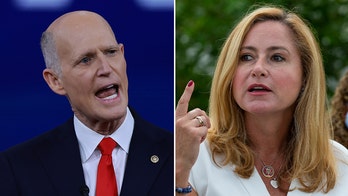Once an obscure branch of study for economists and academics, America’s federal regulatory structure is now one of the hottest topics on the 2012 campaign trail – with GOP presidential contenders regularly taking aim at the Obama administration’s record on the issue, and the president himself defending that record in forums as varied as town halls and a joint session of Congress.
Texas Gov. Rick Perry, the national front-runner for the Republican presidential nomination, decried the “over-regulation” of the last two years in a campaign appearance Friday before members of the Iowa Credit Union in Des Moines.
"It's the onerous regulatory climate that's killing jobs, and it's killing this economy,” Perry said. “That's why I believe the Obama administration should implement a six-month moratorium on all proposed regulations, starting today."
During his major address on job creation last week, President Obama emphasized to lawmakers that while the White House wants to streamline the regulatory process, and ease burdens on employers, there are limits to how far he will go to do that.
“I reject the argument,” the president said in his address to the joint session, “that says for the economy to grow, we have to roll back protections that ban hidden fees by credit card companies, or rules that keep our kids from being exposed to mercury, or laws that prevent the health insurance industry from shortchanging patients.”
Clearly, the issue will figure prominently in the presidential sweepstakes. In the meantime, an analysis by Fox News shows that as a business grows, and an employer hires more workers, that employer must comply with a growing list of federal regulations.
For example, a business with just one employee faces at least 10 federal regulations right off the bat, from predictable requirements like Social Security to more arcane measures like the Polygraph Protection Act.
Grow a business to 25 employees, and the proprietor will contend not only with those regulations the employer of one person faced, but with at least seven additional regulations, from the Civil Rights Act (Title VII) to the Older Worker Benefit Protection Act. The list grows like a beanstalk when the payroll extends to 100 employees.
Small business owners, and those who speak for them, say the regulatory burden can often be felt day to day, in real time.
“Every minute they spend dealing with the regulation is the minute they're not spending growing their business, meeting with customers, developing new products, mentoring employees,” said Todd McCracken, president of the National Small Business Association. “And all those are the components of getting this economy going again.”
During a White House news conference in early summer, Obama expressed skepticism about the alarm business owners have sounded about his policies.
“The business community is always complaining about regulations,” the chief executive said on June 29. “When unemployment is at 3 percent and they're making record profits, they're going to still complain about regulations because, frankly, they want to be able to do whatever they think is going to maximize their profits.”
However studies have also shown that regulations hurt small business owners with disproportionate impact.
In his yearly report, Ten Thousand Commandments: An Annual Snapshot of the Federal Regulatory State, C. Wayne Crews of the Competitive Enterprise Institute, a conservative think tank in Washington, identified 845 rules and regulations proposed in 2010 and expected to affect small businesses – up from 758 the year before, and 753 in 2008.
Of those 845 measures, 501 of them – roughly 59 percent – were generated by five federal agencies: the Departments of Agriculture, Commerce, and Health and Human Services; the Environmental Protection Agency; and the Federal Communications Commission.
And a study by Lafayette College professors Nicole V. Crain and W. Mark Crain for the federal government – entitled “The Impact of Regulatory Costs on Small Firms,” and commissioned by the Small Business Administration – found that in 2010, the cost of compliance with federal regulations, per employee, increased as the size of a firm diminished.
Thus a company with more than 500 employees, according to the Crains’ research, paid $7,755 per employee to keep up with federal regulations, while a firm with fewer than 20 workers paid $10,585 per employee to do the same.
“Small firms typically have a tougher time with it,” Crews told Fox News, “because they can't afford the employees, or the legal team, or the lobbyists to go to Washington to make a rule [have] less of an impact….Sometimes larger businesses can even favor regulations. They can meet the standards. It's no problem for them, but it puts the small guys out of business.”
Neera Tanden, chief operating officer at the Center for American Progress, a liberal think tank in Washington, argued that a strong regulatory regime benefits employers as much as anyone else. “It's actually important for consumers to have faith in the market through those protections of food inspections and other things,” Tanden said in an interview with Fox News.
A former policy aide to then-Sen. Hillary Clinton, Tanden rejected calls for a moratorium on regulation, or for regulators to be forced to meet dollar limits in the impact of the rules they create.
“It doesn't make sense to me to say, you know, ‘If you want to regulate the food from China, all of a sudden we have to start taking away clean air protections, or take away regulations in some other areas.’ That's not being a serious person in government, or being a serious public official.”





